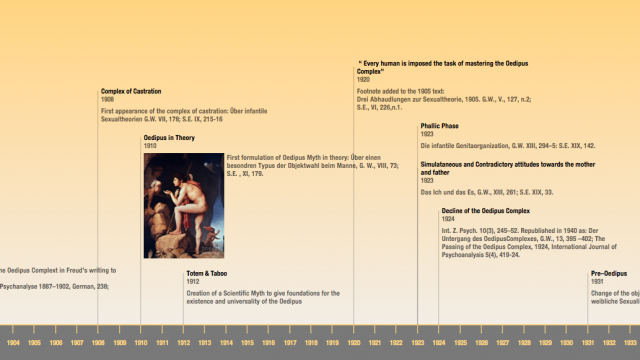From Freudian to Lacanian Psychoanalysis
Winter 2013 Sclinic Course
Saturday April 6th 11:00am – Clarifying the Oedipus Complex: Towards a Logic of Sexuality
Saturday 30th 11:00am
The following for Sat. 11:00 am Course is an outline:
0) List of articles of Freud and timeline on the Oedipus Complex. Article On Narcissism and Chpt. 7 (Identification) of The Ego and Group Psychology should have been read.
1) A construction and critique of R. Guirard article on the Oedipus Complex ( this article will be a major focus, comments, critiques, presentations invited)
2) Review of other major post-freudian writers on the OE. Levi-Strauss's model is important to construct (See Structural Anthropology).
3) Formalization in Lacan's Masculine/Feminine Logic and clinical examples (pedophilia, obsessional, politiphilia, psychosis, etc.)
4) Extension into the philosophical (intrinsic/extrinsic ontology) and mathematical problems (topology, set theory, category theory).
=================================================================================
People have proposed that the Oedipus Complex be focussed on in its logical-set theoretical development as it was put forward at the Public School presentation this last Saturday, the 23rd of March 2013.
I would go along with this and propose that we work backward – analytically, from whole (OE) to part (identification/object choice) – to bring out what is at stake and
show how Lacan formalized the OE into masculine and feminine logic in order to make these problems precise. This masculine/feminine distinction, in fact, corresponds respectively and precisely to the distinction between neurosis and psychosis. Which is the title of this year's course: Psychosis and Neurosis in a theory of knots. These problems will be brought out
in the Summer Immersion as the first geometrization problems in logic.
What I ask, therefore, for those attending the Sclinic is to take up the following questions and respond slowly and precisely:
1) How is the OE formalized into the Masculine Feminine logic ? (See Lacan's Encore and the Logic of the Fantasm). Explain the difference between Freud's OE and
Lacan's OE. Explain the difference between a theory of the group as ego identifications and object choice, then show where the subject comes in and a fantasy object.
a) To respond to the logical problem, you will need to read the rudiments of predicate logic and become familiar with the Aristotlean square. That is a minimum.
b) I wrote an article on this that was published 6 years ago Umbra (Science and Truth). This will be made available to whoever requests it.
2) How does this formulation into a modified logic occur in five ways:
i/ resolution of the paradox of Russell and its formulation in Separation Axiom of Zermelo (Masculine Logic): show how the Cone construction is the Zermelo Separation axiom -
then show how the petite a – fantasy object – results as a limit constant on the universal. (This problem will be introduced as the first geometrization of logic in Topos theory).
ii/ resolution of the paradox of Russell and its formulation into a theory of types (Russell -Tarski-Bourbaki) (Feminine Logic)
iii/ resolution of the modern paradoxes (Russell, Berry, Grelling, etc.) in topology (Masculine and Feminine Logic)
iv/ resolution of the modern aporias of Ontology: intrinsic (Badiou) and extrinsic (Deleuze, Desanti, and Heidegger)
v/ formalizes the aporias of Theology in the birth of modern science (Kojeve, Koyre) and psychoanalysis (Lacan)
You should try to work through the Separation theorem of Zermelo to make the proof for yourself of what is at stake and what are the logical conditions for such a set theoretical axiom. They will, however, reproduced on Saturday with a view of going over what may have been presented to quickly this past Saturday.
3) How a Masc./Feminine Logic reopens and precisely formalizes the following clinical problems:
a) Pedophilia (explain using the OE and Feminine logic)
b) Politiphilia (explain using the OE and Masculine logic)
c) Neurosis (explain using the OE with hysteria-obsessional as Masculine logic) (Explain how this logic formalizes Hegel's Beautiful Soul)
d) Psychosis (Paraonia-Schizophrenia explain using the OE with psychosis as Feminine logic)
e) Perversion (explain using the OE of masculine logic)
f) Homosexuality (explain the reduced symmetric theory and extended asymmetric theory)
4) Show how three different types of holes can be introduced using the Masc. /Feminine logic distinction:
a) real hole (neurosis)
b) symbolic hole (psychosis)
c) imaginary hole (perversion)
then show how each one of these holes corresponds to a topological operator that condenses the Freudian operations of:
a) Uverdrangung
b) Verwufung
c) Verlungung (?)
then show how these differences are to be distinguished in the use of the difference between:
a) Sinthome (Latin Version)
b) Symptome (Greek version)
Any questions, reformulations, and/or new proposals will be made room for this Saturday, 11:00am, at Euclid.
Sincerely, RTG
The Painting and Topology of Repression
What is the difference between Neurosis and Psychosis?
In the first semester we showed how Freud first makes the difference between primary repression (Uverdrängung)
and foreclosure (Verwerfung), while Lacan called this a hole in the real and a hole in the symbolic. What is not often distinguished is that it is only the former that is called 'Traumatic'.
The Fall 2012 Course explained this difference by showing how the first establishes the basis for a clinic of neurosis and the second the basis of psychosis. We introduced this difference by first reading Freud's Gradiva and his commentary on F.Rop's Temptation of St. Anthony as being a 'painting of repression'.
In the second Winter 2013 semester we pass to Lacan's topology of repression in showing how he constructs the difference between the neurotic structure of Joyce and psychotic structure of Schreber in formulating a
theory of nonknots and knots.
The Winter Course begins at 11:00am January 26, 2013 and meets once per month on Euclid in Santa Monica, CA.
For more information on enrollment see:
Sclinic and the
Interface Site
From Freudian to Lacanian Psychoanalysis



Comments are closed, but trackbacks and pingbacks are open.